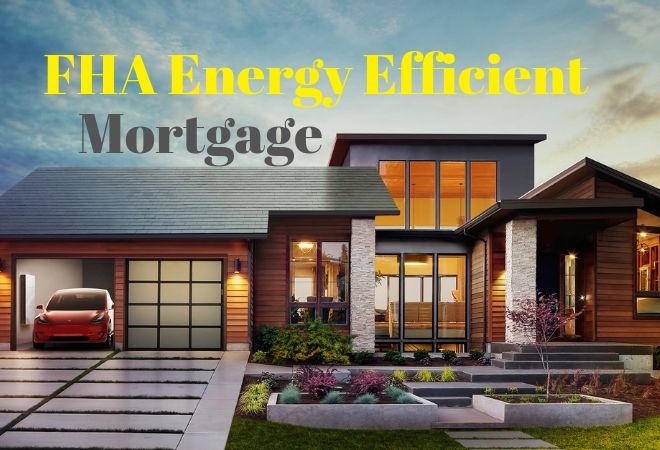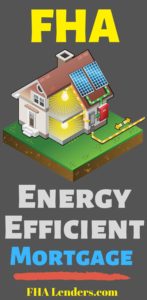FHA Energy Efficient Mortgage Program

Many home buyers are not fortunate enough to purchase new energy efficient homes. The majority of the home sales are for homes that have older services in the home, poor insulation and other characteristics which lead to a home that is not very efficient. To help, HUD developed the FHA Energy Efficient Mortgage program.
What is the FHA Energy Efficient Mortgage Program?
The FHA Energy Efficient Mortgage program (EEM) was developed to help home buyers to save money on their utility bills by making energy efficient improvements in the home. The program would allow home buyers to borrow up to an additional 5% of the home value to make those improvements.
The program should result in a net monthly savings for the home owner when you factor in the total  energy savings per month minus any small increase in mortgage payment to cover the financed improvements.
energy savings per month minus any small increase in mortgage payment to cover the financed improvements.
The FHA will insure the mortgage and protect the lender in the event the borrower defaults on the loan. There are FHA energy efficient mortgage lenders who will participate in this program. Keep in mind that although this is an FHA approved program, not all FHA lenders will offer it.
Click to connect with an FHA Energy Efficient Mortgage Lender
How the FHA Energy Efficient Program Works
The borrower must develop an energy package which is the list of improvements that will be made based upon the recommendation of a qualified home energy rater. The energy rater does a complete analysis of the home and identifies the improvements that can be made using energy efficient equipment in a home energy report
The energy package can include all inspections, labor and materials based upon the recommendation of the energy rater. If there is a project manager involved, the cost for that manager can also be included in the loan.
After the home energy report is finished, the energy package must pass a cost-effective test. This test essentially determines whether the cost of the improvements is less than the total energy savings over the life of the equipment being installed.
As an example, if the recommendation is to install a new AC unit and furnace and those will cost a combined $8,000, then the energy savings over the expected life span of those units must save at least $8001 in energy costs.
The total cost of improvements cannot exceed the maximum financeable energy package limits.
Qualified Energy Rater
The qualified energy rater who conducts the home audit and develops the energy package must be trained or certified in ONE of the following areas:
- Residential Energy Services Network Home Energy Rater
- Building Performance Institute Home Energy Professional Energy Auditor
- Building Performance Institute Building Analyst Professional
You may be able to find a professional energy rater here.
What is the Maximum Financeable Energy Package Limit?
FHA guidelines have established a maximum amount that you can borrow under this program. First, you have the base loan amount for the purchase of the home. Then, you add the lesser of the following:
- The dollar amount of the energy package as determined by the home energy report.
- 5% of the adjusted value of the home
The maximum amount for the program is $8,000. Therefore, if your home is worth $200,000, 5% would be $10,000. In this case the maximum amount would still be $8,000 or the total amount needed based upon the home energy package/report. Whichever is lower.
This comes directly from the FHA Handbook 4000.1 and seems to be confusing. We suggest having your lender help to determine what the maximum amount is that you can borrow for your specific circumstance.
Who is Eligible for the FHA Energy Efficient Mortgage?
Anyone who can qualify for an FHA mortgage is eligible for the program. You can read our article on FHA loan requirements to fully understand what the minimum qualification requirements are for an FHA loan.
Eligible Properties
You can use the energy efficient mortgage (EEM) with any of these property types:
- Existing homes (1-4 units)
- New construction homes (1-4 units)
- Manufactured housing (modular or mobile home)
- Condominiums – single unit
The property eligibility essentially mirrors that of the standard FHA property eligibility guidelines.
Which Energy Efficient Improvements Qualify for the Program?
The following energy efficient improvements are examples of what the qualified energy rater will recommend in his or her energy plan. These are just some examples and the list is subject to change:
- New or improved insulation
- Replacement or repairing or air conditioning unit
- Replacement or repairing of the heating system
- Replacement of the hot water heater
- Solar panels
- Solar powered exterior lighting
- Motion activated lighting for both exterior and interior
- Smart thermostats
- Conversion to LED light bulbs
- Water efficient shower heads and faucets
- Energy efficient windows and doors
The improvements must prove to be cost effective and produce a savings return that exceeds the cost of the improvements.
Read this related article on how to make recessed lighting energy efficient.
FHA Energy Efficient Mortgage (EEM) Pros and Cons
PROS
- You can finance the energy efficient improvements all in one loan
- The program still has the benefit of a low FHA down payment
- The interest rates will be extremely competitive vs conventional loans
- Credit scores down to 500 permitted and ratios allowed are higher
- The program can be combined with FHA 203k or FHA streamline refinances
CONS
- Loan cap of $8,000 (or 5% of the purchase) limits the improvements that can be made
- The cap also limits the ability to make the home truly energy efficient
- You are financing and paying interest on the improvements for the life of the loan
One of the things to consider with an EEM is whether you have enough money from the program to truly make the home energy efficient. The program allows for the replacement of windows and doors for example. However, it would be difficult to replace them all using a contractor for a cost of $8,000.
Solar panels would cost even more but you can get into a lease or rental program with no out of pocket expenses.
FHA Energy Efficient Mortgage Escrow Account
The lender must establish an escrow account to manage any improvements that still must be made after closing. The borrower has 90 days to make those improvements, otherwise the dollars in escrow will be applied against the mortgage balance.
FHA Energy Efficient Mortgage Down Payment
The down payment for this program is the same as any other FHA program. It will be 3.5% for credit scores 580 and over or 10% for credit scores between 500 and 579. The down payment will be calculated from the purchase price of the home. It will not factor in total loan amount once you add in the cost of the energy improvements.
FHA Energy Efficient Mortgage Appraisals
When the home is appraised, it should only reflect the current value of the home without the future energy improvements factored in. However, if you are financing with an FHA 203k loan, then you can include those energy efficient improvement costs.
Are Cash Out Refinances Permitted?
Under this program, no cash out is allowed from the transaction. If there are funds remaining after the improvements have been completed, they must be applied against the mortgage balance.
FHA Stretch Ratios
When a that is being financed meets (or will meet after improvement are made) the minimum energy efficient standards, the FHA guidelines permit the ratios to be stretched by 2% over the standard back end ratio limits.
The theory behind stretch ratios is the borrower’s increased ratios would be offset by the monthly utility bill savings they will incur.
This means borrowers may qualify for a larger loan amount under this program. Depending upon your income and prevailing interest rates, this could result in the ability to afford a larger home.
Meanwhile, there are lender in our network who already permit ratios even higher than what is outlined in the stretch ratio program.
Energy Star Partnership for FHA Lenders
The Energy Star program offers a partnership program to FHA lenders who in turn offer FHA Energy Efficient Mortgages. In return for offering this mortgage program, the lenders are permitted to use the Energy Star brand and logo to promote their businesses. Lender must meet certain criteria established by Energy Star to be part of their program.
** Important – Lenders do not have to partner with Energy Star to offer Energy Efficient Mortgage Programs. In fact, most lenders don’t collaborate with Energy Star. As a result, you likely should not use this as a basis for choosing an FHA Energy Efficient Mortgage lender.
Summary
If you are buying a home that has older heating and cooling, older windows, and also poor insulation, then the FHA energy efficient mortgage (EEM) may be a great option for you. Something to consider is whether you can make all of the energy improvements needed while staying under the cap for the program. You may have to finance some of the improvements and pay for the rest out of pocket.
You also need to realize that you are financing these improvements for 30 years. If you have the money to pay for the energy efficient upgrades out of pocket, that may be your most cost effective option.
If you would like to get a rate quote from an FHA energy efficient mortgage lender, then click to fill out our contact form.
Related Articles
How to Choose the Right Light Bulb – this helpful article will show you how to select the right light bulb for every room in the home. This will help not only with the look and feel of the room but also the energy costs.
Increase Home Value with Renewable Energy – In this article, learn how to increase your home’s value by installing renewable energy while learning about the costs and benefits.